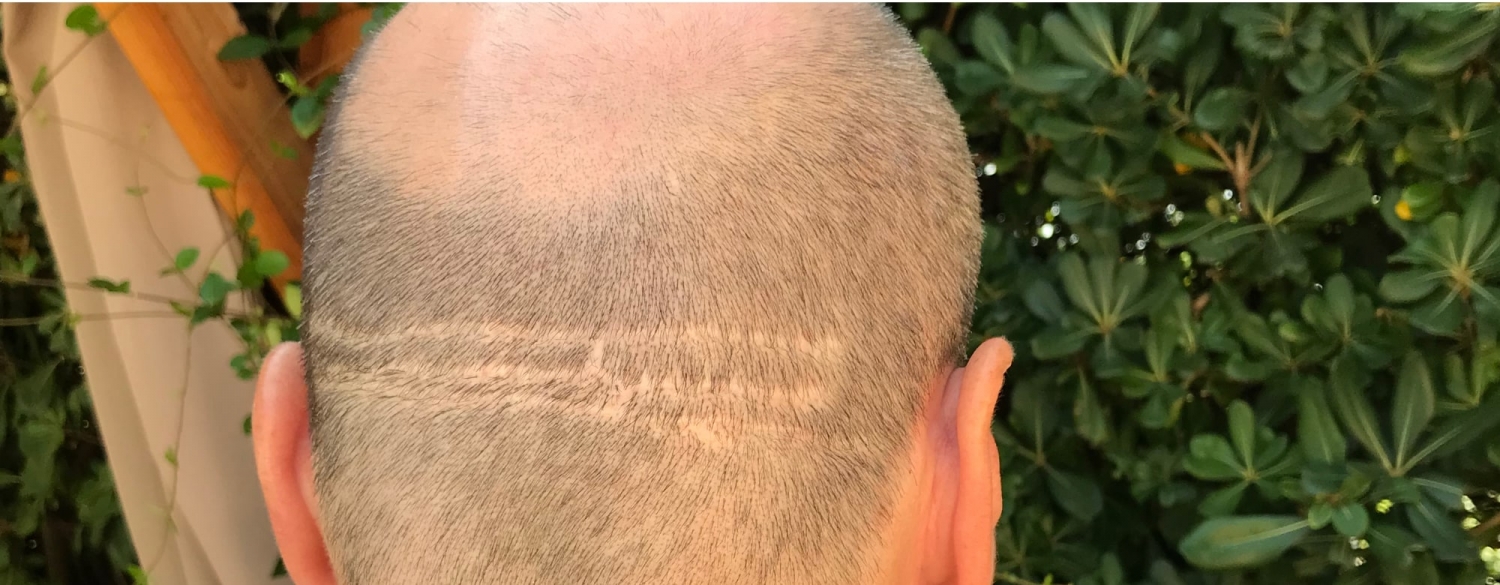Scars


Scars
Scars on the scalp can have multiple causes: post-traumatic causes (accidents, burns, etc.), post-surgical causes (linear scarring after a FUT procedure or punctiform after FUE performed with large diameter punches) or inflammatory causes.
On scar tissue, no hair will be able to grow naturally and in the majority of cases, it will therefore be a matter of reducing the visibility of the scar. Thanks to hair surgery, this is now possible!
Several processes are conventionally used to treat or rather camouflage scars:
- the first of these is resection-suture, which involves excising the scar and leaving another more inconspicuous one. If the new scar remains thin after a few months, the improvement will be clearly visible. But this process does not always work as we might hope, and sometimes an enlargement of this new scar occurs.
- the second is to tattoo the scar with medical pigments that will lessen the contrast between the scar and the hair: this is known as SMP (scalp micropigmentation).
This last option may be suggested to you: it consists of a micro-tattoo made of small drops of semi-permanent, absorbable medical ink, which will be able to decrease the whiteness of your scar and make the contrast with the rest of the hair less visible. This process must be repeated about once a year because macrophages, cells of the human body responsible for, among other things, cleaning the latter phagocytose these small drops of ink and gradually eliminate them.
For this reason, we do not perform this procedure at our centre.
Recently a laser pigmentation technique has appeared, the future will tell us how effective it is.
- the third is a micro-hair transplant on the scar.
For surgical scars: whether they are the marks of a head trauma or any other pathology of neurological origin, hair transplantation will make it possible to hide the scar on your scalp in an extremely natural way. The same goes for accidental and inflammatory scars.
Hair transplantation to reduce scars from accidents or burns
Scars can occur for very different reasons. After an accident or an operation, they sometimes remain large and visible. The same goes for burns, or scars that can affect the entire head.
An implantation of your own hair can cover the scars and can allow you to regain your well-being.
Hair implants on scar tissue are one of the procedures frequently performed at our NHT Europe centre.

Post-traumatic scar
Undergo a hair transplant to hide a scar?
A hair transplant can completely hide scars, especially on the top of the head or on the sides. However, a major difficulty must be highlighted: the fibrous tissue has little or no vascularization and therefore a graft implanted in this tissue cannot survive; it must therefore be implanted more deeply, under the fibrous tissue until it reaches the healthy tissue and the vascularization under the scar or induce vascularization in the scar itself.
This preparation of the area is essential to increase the percentage of graft regrowth, and is carried out by injecting stem cells taken from fat under local anaesthetic.

Scar from an accident
The possible options to conceal your scars
To improve the fibrous tissue and soften your scar, you should first undergo a nano fat graft.
This procedure is very often used in cosmetic surgery (on the face for example). It consists of taking fat from a roll of body fat under local anaesthesia and reinjecting it in the scar tissue after a process of centrifugation and increasingly fine filtration. You will see, this innovative technique will allow stem cells to be injected into the area to be treated and thus recreate healthy tissue that is more conducive to hair regrowth.
New vascularization is also induced, allowing the possibility of a transplant to be considered. Great improvement can often be observed, allowing a smoothing and a softening of the tissue, or even hair regrowth before the transplant.
The indications for these injections are mainly fibrous and thick scars, but also post-inflammatory atrophic scars.
Following this fatty tissue graft, an FUE micrograft can be considered. The area is "ready".
Indeed, without this fat graft, it is not certain that a hair transplant will take.
In summary: in order to survive, the graft must be vascularized, i.e., implanted in healthy or at least vascularized tissue; this can be done by implanting the graft deeper to exit the fibrous area or by neovascularization by injecting stem cells that will “repair” the scar tissue.
In summary: hair transplantation is ideal for masking an unsightly scar
Hair transplantation conceals the scar tissue on your scalp. This procedure is recommended especially for large and very visible scars. It can help you to regain self-confidence.
The essential information
Most of the time, hair transplantation on a scar must be preceded by an injection of fat (nanofat grafting) to improve tissue quality; with this condition most scars can be treated, and their visibility reduced.
Please note that the NHT center is closed from August 4 until August 24 inclusive.
An answer will therefore be provided to you by a doctor from the center as soon as it reopens.
NHT EUROPE


